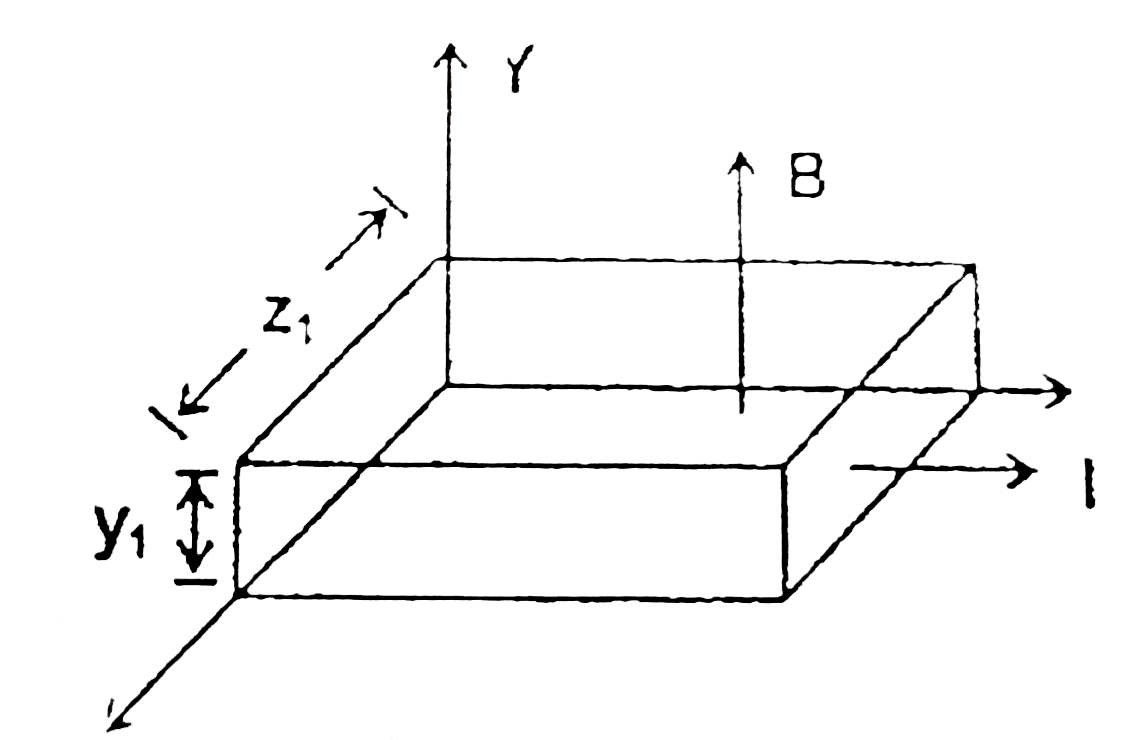The basic principle underlying the Hall effect is the Lorentz force. When an electron moves along a direction perpendicular to an applied magnetic field, it experiences a force acting normal to both the directions and moves in response to this force and the force exerted by the internal electric field. For an n-type, bar-shaped semiconductor, the carriers are predominantly electrons of bulk density n. We assume that the constant current I flows along the x-axis from left to right in the presence of a magnetic field toward y-axis. Electrons subjected to the lorentz force initially drift away from the current line toward the negative z-axis, resulting in an excess surface electrical charge on the sides of the sample. This charge results in the hall voltage, a potential drop across the two sides of the sample.
The transverse voltage is the hall voltage VH and its magnitude is equal to IB/qnd, where I is the current, B is the magnetic field, d is the sample thickness and q is the elementary charge. A silver ribbon lies as shown in the adjacent figure. (z1=11.8mm and y1=0.23mm) carrying a current of 120A in the x-direction in a uniform magnetic field B=0.95T. If electron density is 5.85×1028/m3, then
What is the value of hall emf ?

53mV
53μV
5.3mV
5.3μV
Step by step video & image solution for The basic principle underlying the Hall effect is the Lorentz force. When an electron moves along a direction perpendicular to an applied magnetic field, it experiences a force acting normal to both the directions and moves in response to this force and the force exerted by the internal electric field. For an n-type, "bar"-shaped semiconductor, the carriers are predominantly electrons of bulk density n. We assume that the constant current I flows along the x-axis from left to right in the presence of a magnetic field toward y-axis. Electrons subjected to the lorentz force initially drift away from the current line toward the negative z-axis, resulting in an excess surface electrical charge on the sides of the sample. This charge results in the hall voltage, a potential drop across the two sides of the sample. The transverse voltage is the hall voltage V_(H) and its magnitude is equal to IB//qnd, where I is the current, B is the magnetic field, d is the sample thickness and q is the elementary charge. A silver ribbon lies as shown in the adjacent figure. (z_(1)=11.8 mm and y_(1)=0.23 mm) carrying a current of 120 A in the x-direction in a uniform magnetic field B=0.95 T. If electron density is 5.85xx10^(28)//m^(3), then What is the value of hall emf ? by Physics experts to help you in doubts & scoring excellent marks in Class 12 exams.
Updated on:21/07/2023Similar Questions
चुम्बकीय क्षेत्र में उसकी दिशा के समान्तर एक इलेक्ट्रॉन गति कर रहा है। इलेक्ट्रॉन पर बल
View SolutionIntroduction OF Magnetic Field || Oersted Experiment & Magnetic Field Direction || Force on a Moving Charge || Formula OF Force on Moving Charge || Rules for Direction OF Force on Moving Charge
View SolutionAn electron having charge e moves with velocity vecv in +x direction. An electric field acts on it along +y direction. The force on the electron acts along-
View SolutionAn electron is moving along X axis and a magnetic field is directed along Y axis. What will he the direction of magnetic force acting on the electron?
View SolutionLorentz Force:
If a charge +q is moving in an electric field E, it experiences a force qE called Lorentz electric force.If the charge q is moving in a magnetic field →B, it experiences a force (→v×→B) called Lorentz magnetic force. If charge q is moving in a n electric field E as well as in magnetic field →B simultaneously, the total force experience by the charge is the sum of these two forces and is called total Lorentz force.
The direction of electric force is
View SolutionLorentz Force: If a charge +q is moving in an electric field E, it experiences a force qE called Lorentz electric force.If the charge q is moving in a magnetic field vecB , it experiences a force (vecvxxvecB) called Lorentz magnetic force. If charge q is moving in a n electric field E as well as in magnetic field vecB simultaneously, the total force experience by the charge is the sum of these two forces and is called total Lorentz force. Magnetic Lorentz force on the charge depends upon the strength of
View SolutionLorentz Force: If a charge +q is moving in an electric field E, it experiences a force qE called Lorentz electric force.If the charge q is moving in a magnetic field vecB , it experiences a force (vecvxxvecB) called Lorentz magnetic force. If charge q is moving in a n electric field E as well as in magnetic field vecB simultaneously, the total force experience by the charge is the sum of these two forces and is called total Lorentz force. If the charge is q is moving perpendicular to the magnetic field B, the work done by the magnetic field is
View SolutionLorentz Force:
If a charge +q is moving in an electric field E, it experiences a force qE called Lorentz electric force.If the charge q is moving in a magnetic field →B, it experiences a force (→v×→B) called Lorentz magnetic force. If charge q is moving in a n electric field E as well as in magnetic field →B simultaneously, the total force experience by the charge is the sum of these two forces and is called total Lorentz force.
If →v is perpendicular to →B the charged particle moves in a
View Solution